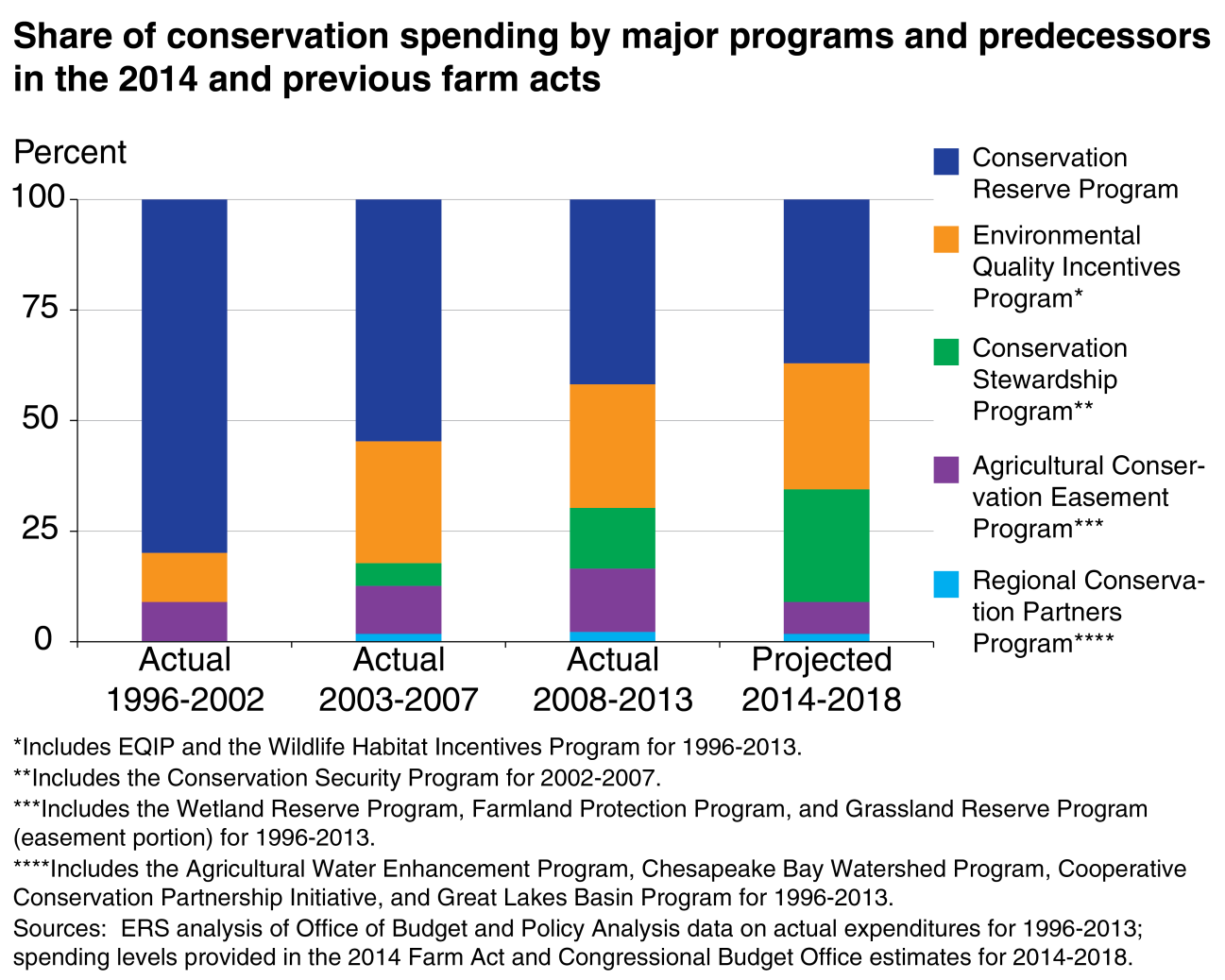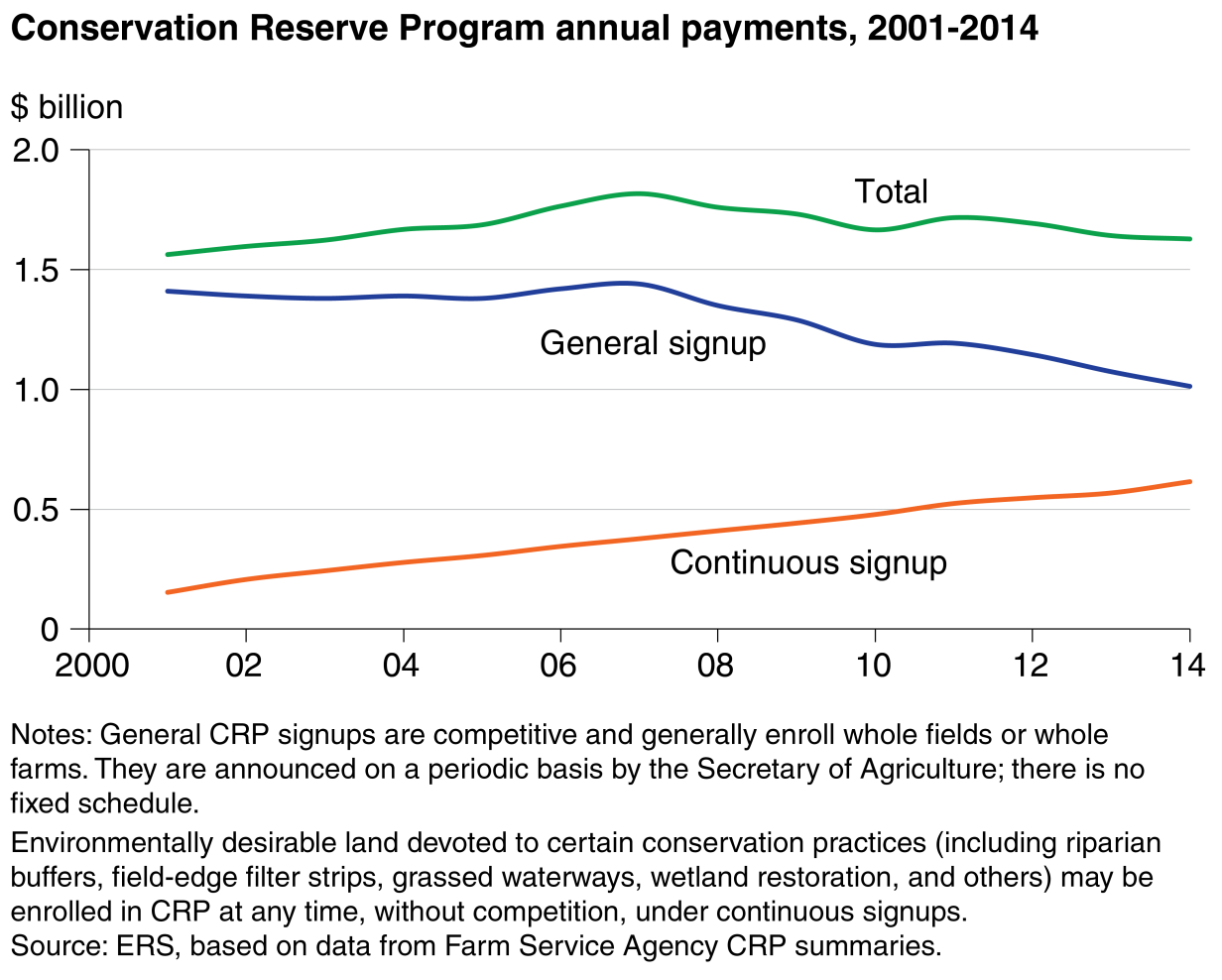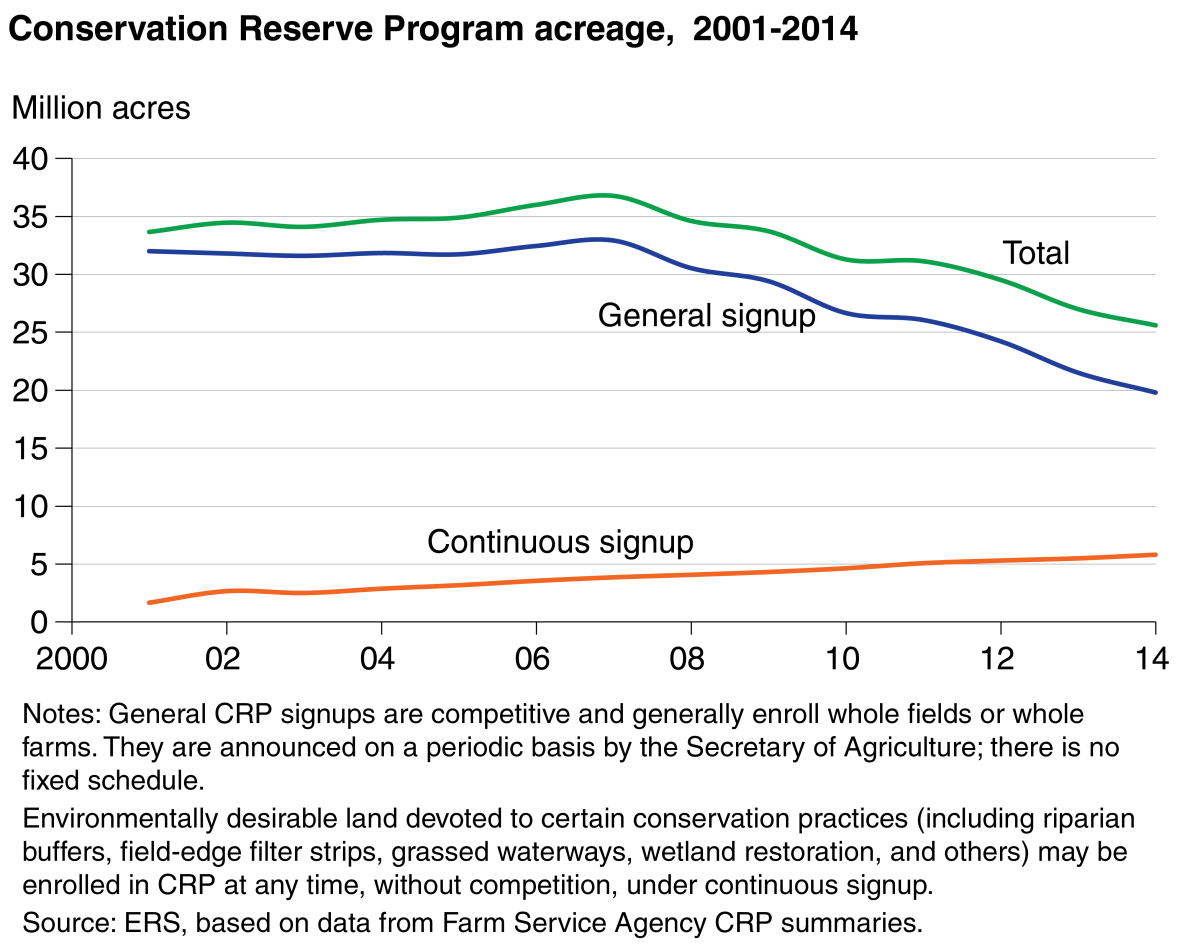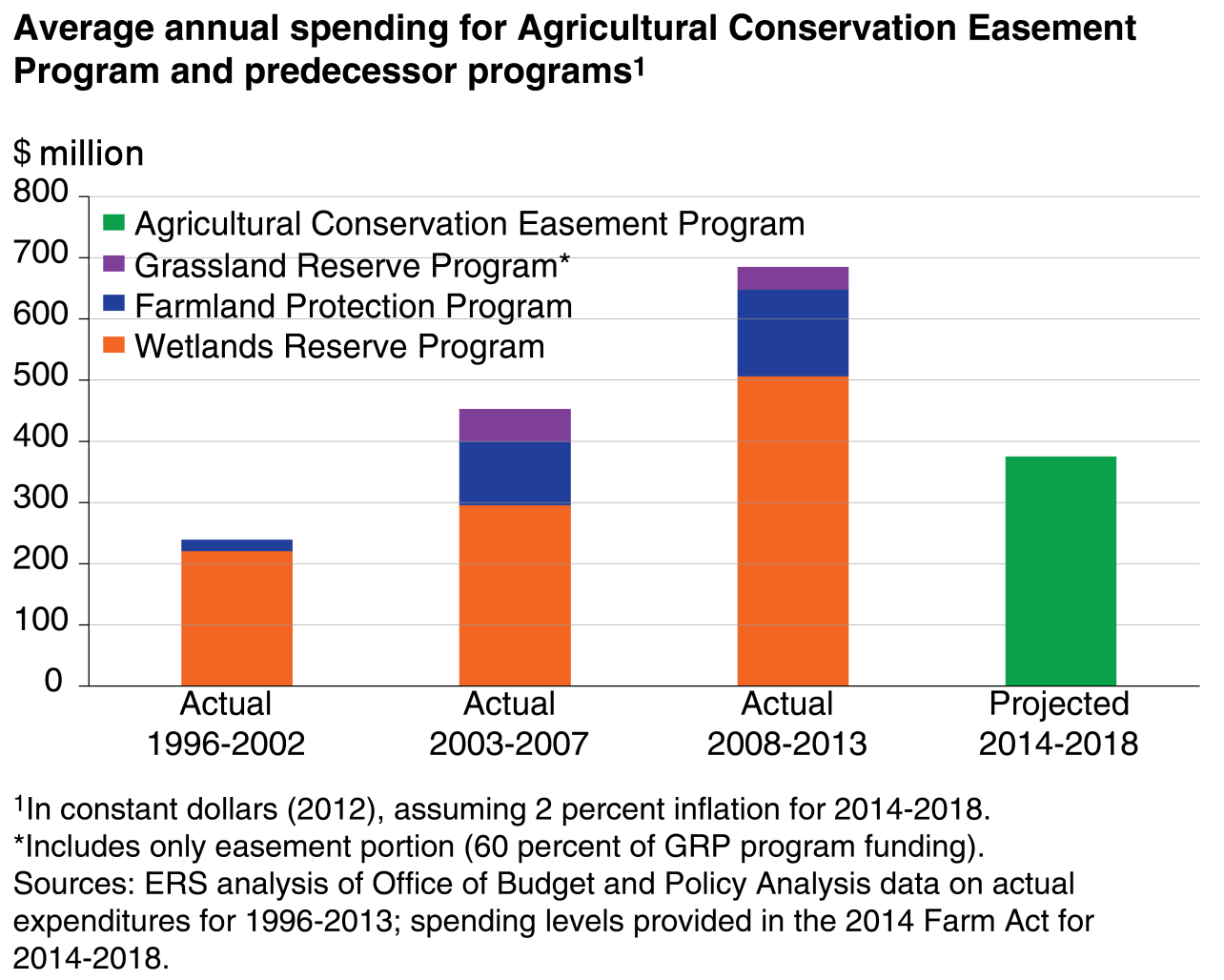Conservation: Title II and Title XI (Crop Insurance)
Provides assistance to producers and landowners to adopt conservation activities on agricultural and forest lands to protect and improve water quality and quantity, soil health, wildlife habitat and air quality. Program practices range from conservation activities that address natural resource issues and benefit productivity of agricultural working lands, forestlands, and grasslands to wetlands restoration and temporary or permanent land retirement
Highlights
- Continues emphasis on conservation on working lands.
- Gradually reduces Conservation Reserve Program (CRP) cap from 32 million acres to 24 million acres by 2017.
- Consolidates many conservation programs into new programs or merges them into existing programs, reducing the number of USDA conservation programs from 23 to 13.
- Re-links crop insurance premium subsidies to Conservation Compliance (conservation of highly erodible land and wetlands) for the first time since 1996.
New Programs and Provisions
Agricultural Conservation Easement Program (ACEP)—Funding is provided for long-term easements for the restoration and protection of onfarm wetlands and protection of eligible agricultural land from conversion to nonagricultural uses. ACEP consolidates the functions of the Wetlands Reserve Program, the Grassland Reserve Program (easement portion), and the Farmland Protection Program. All land enrolled in these programs on the date of enactment of the 2014 Farm Act will be considered enrolled in ACEP. Annual funding is significantly less than that provided for ACEP predecessor programs in the 2008 Farm Act.
Regional Conservation Partnership Program (RCPP)—Program is designed to coordinate conservation program assistance with partners to solve problems on a regional or watershed scale. The RCPP consolidates functions of existing regional programs: Agricultural Water Enhancement Program, Chesapeake Bay Watershed Program, Cooperative Conservation Partnership Initiative, and Great Lakes Basin Program. RCPP is funded at $100 million annually, plus 7 percent of the funding or acres for the Environmental Quality Incentives Program, Conservation Stewardship Program, Agricultural Conservation Easement Program, and Healthy Forests Reserve Program will be directed through RCPP. Assistance is delivered to participants through these covered programs.
Environmental Quality Incentives Program (EQIP)—Program continues financial assistance to producers to install and maintain conservation practices on eligible agricultural and forest land. In the 2014 Farm Act, EQIP incorporates the functions and funding of the repealed Wildlife Habitat Incentive Program, with at least 5 percent of program funding targeted to practices benefiting wildlife habitat.
Conservation Stewardship Program (CSP)—Program continues financial assistance to producers who meet stewardship requirements on agricultural and forest lands. The 2014 Farm Act raises the bar for CSP enrollment to meeting the stewardship threshold for two resource concerns. Annual enrollment is set at 10 million acres, down from 12.769 million acres under the 2008 Farm Act.
Crop Production on Native Sod (“sodsaver”)—For producers who choose to till native sod, provision would reduce crop insurance premium subsidies and limit the yield or revenue guarantee available during the first 4 years of crop production on native sod that had not been previously tilled. Some limitations would also apply to noninsured crop disaster assistance. The new provision applies only to native sod in Minnesota, Iowa, North Dakota, South Dakota, Montana, and Nebraska.
Repealed Programs and Provisions
Wetlands Reserve Program, Farmland Protection Program, and the easement portion of the Grassland Reserve Program are consolidated into the Agricultural Conservation Easement Program (ACEP).
Agricultural Water Enhancement Program, Chesapeake Bay Watershed Program, Cooperative Conservation Partnership Initiative, and Great Lakes Basin Program are consolidated into the Regional Conservation Partnership Program.
Wildlife Habitat Incentive Program is merged into the Environmental Quality Incentives Program, with at least 5 percent of funds set aside for wildlife habitat-related practices.
Noneasement functions of the Grassland Reserve Program will be carried out through the Conservation Reserve Program (grassland enrollment of up to 2 million acres is authorized).
Comprehensive Conservation Enhancement Program, Emergency Forestry Conservation Reserve Program, and Environmental Easement Program are repealed.
Economic Implications
The Congressional Budget Office (CBO) estimates that between 2014 and 2018, mandatory spending on USDA conservation programs will decline by $200 million, or less than 1 percent of the $28 billion that CBO projects would have been spent had the 2008 Farm Act been continued through 2018. These funding levels, however, are not guaranteed. Conservation funding has been reduced from initial levels mandated by previous Farm Acts.
The share of mandatory conservation funding devoted to land retirement (the Conservation Reserve Program, or CRP) and conservation easements (Agricultural Conservation Easement Program, or ACEP, and predecessor programs (see chart)) will decline during 2014-2018, and the share of conservation funding for working land conservation programs (the Environmental Quality Incentives Program, or EQIP, and the Conservation Stewardship Program, or CSP) will rise, compared with actual spending during 2008-2013. Combined funding for EQIP and CSP is projected to account for more than 50 percent of conservation spending during 2014-2018. These programs (and predecessors) accounted for just over 40 percent of spending during 2008-2013, 32 percent during 2003-2007, and 11 percent during 1996-2002.
Although CSP funding will be higher during 2014-2018 than during 2008-2013, a large share will go to servicing CSP contracts signed during 2008-2012. Under the 2008 Farm Act, USDA was directed to enroll up to 12.789 million acres per year. The 5-year contracts can be extended for 5 more years, ensuring that extended contracts will be active until at least 2018. The 2014 Act authorizes enrollment of up to 10 million more acres each year during 2014-2018.

While the new CRP acreage cap cuts maximum enrollment by 25 percent, the impact on program enrollment and related environmental benefits may be relatively modest. CRP acreage has been declining since 2007, falling from 36.8 million acres to 25.6 million—30 percent—by December 2013. Environmental benefits, however, may not be diminishing as quickly as the drop in enrolled acreage might suggest. CRP has shifted rapidly from enrolling whole fields or farms (through general signup) to funding high-priority, partial-field practices, including riparian buffers, field-edge filter strips, grassed waterways, and wetland restoration (through continuous signup). On a per-acre basis, these practices are believed to provide greater environmental benefits than whole-field enrollments while taking less land out of crop production. Because partial-field practices are more expensive, however, CRP annual payments have fallen by only 10 percent since 2007. At the end of 2013, the average annual payment for partial-field practices was $103 per acre, versus only $50 per acre for whole fields.


Funding for new wetland easements—an important component of agricultural conservation policy under the 2002 and 2008 Farm Acts—is likely to decline under the 2014 Farm Act. In particular, funding for the Wetlands Reserve Program (WRP) was increased in the 2002 and 2008 Farm Acts, while the 2014 Farm Act merges WRP functions into ACEP but at much lower funding. Even if all ACEP funding for the next 5 years was devoted entirely to wetland protection, it would be only 73 percent of WRP funding under the 2008 Farm Act, and doing so would leave functions previously covered by the Farmland Protection Program and the Grassland Reserve Program unfunded.

Errata: On October 30, 2017, this chart was reposted to correct the axis label to $ million.
The 2014 Farm Act adds crop insurance premium subsidies to the list of benefits that could be withheld for noncompliance with conservation provisions, thus maintaining farmer incentives for environmental stewardship. Producers who fail to apply approved soil conservation plans on highly erodible cropland or who drain wetlands could become ineligible for all or part of a number of agricultural programs, including commodity programs, conservation programs, disaster assistance, and now crop insurance premium subsidies. In recent years, the value of such subsidies rose sharply as the premium subsidy rate, crop insurance participation, and commodity prices all rose. On average, the Federal Government pays roughly 60 percent of crop insurance premiums, and about 80 percent of acreage for all major commodity crops is now covered by crop insurance. In 2012, crop insurance premium subsidies were roughly $6.7 billion or about 60 percent as large as commodity, conservation, and disaster assistance payments combined.

